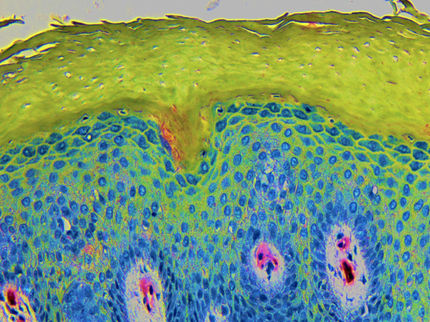Allergy risk: Metal particles from tattoo needles detected in the skin for the first time
Particles containing nickel and chromium also enter the lymph nodes
Micro and nanoparticles of metal from tattoo needles can be deposited in the skin and in lymph nodes. This is the result of researchers from the German Federal Institute for Risk Assessment (BfR), together with an international team of partners. Tattoo needles are made of steel, so they also contain nickel (6-8%) and chrome (15-20%). The research team has now demonstrated that metal particles can be abraded from the needle during use and penetrate into the skin if the tattoo ink contains the white pigment titanium dioxide (TiO2). Nickel and chromium are mechanically released from the needle and enter the skin. Subsequently, these particles can then migrate into the lymph nodes. Until now, it was thought that mainly colour pigments (tattoo inks) contaminated with nickel and chromium cause metal-related tattoo allergies. With this new study, the researchers now provide evidence that even tattoo needles pose a health risk. In addition, contamination of the body increases with nickel and chromium. Future studies will investigate how the additional intake of these metals increases the probability of triggering allergies.

Symbolic image
ilovetattoos, pixabay.com, CC0
Allergic reactions to tattoos and their ingredients are among the most common side effects of tattooing. Based on the research results, scientists assumed that colour pigments contaminated with heavy metals in particular were responsible for triggering these allergies. Although tattoo needles contain nickel and chromium, their influence on metal deposition in the skin has not yet been studied.
An international team led by the BfR has now closed this research gap. The researchers first analysed samples of human skin and lymph nodes using synchrotron-based nano x-ray fluorescence (XRF). They were sourced from tattooed donors without any known health abnormalities. The results of these samples were compared with data from the skin and lymph nodes of a tattooed patient experiencing an allergy.
In the second part of the study, the research team tattooed pig skin in one instance with black ink (carbon-based) and in another with TiO2 ink, the latter having abrasive properties. Both pigments were previously examined and found to contain no steel particles.
The results of both analyses indicate: Nano- and micro-sized metal particles are released from tattoo needles through the use of TiO2-containing ink. This effect was much lower for black ink. The metal particles contain nickel and chromium, are permanently deposited in the tattooed skin and are also partially transported into the lymph nodes. In the analysed samples of a patient suffering from an allergic reaction, the team of researchers detected both colour pigments (iron oxide) and abraded steel particles in the inflamed skin. The results show that with the use of tattoo needles, nickel and other heavy metals can enter the body and may trigger allergic reactions.
Further research is needed to assess the exact effect of particles abraded from tattoo needles in the case of metal-related tattoo skin allergies.























































